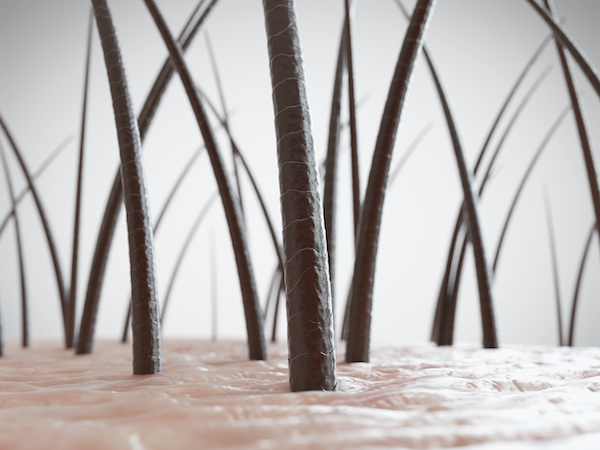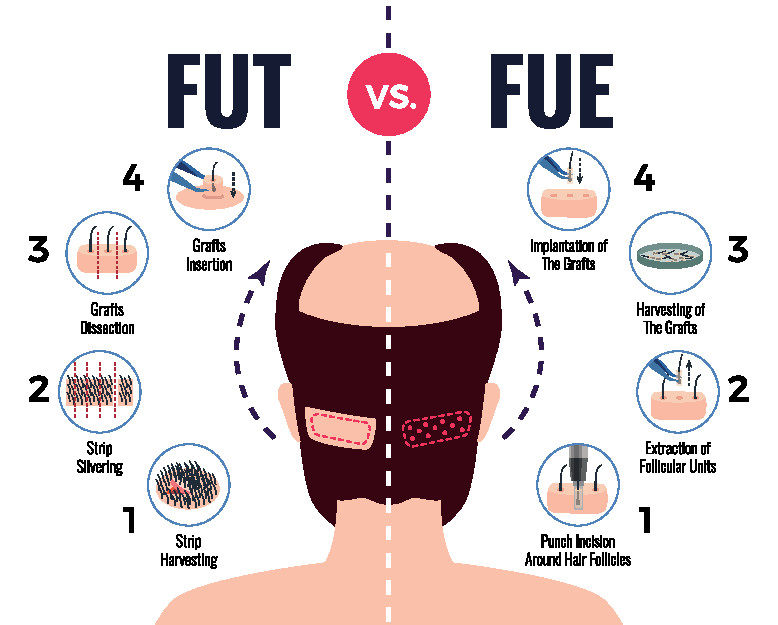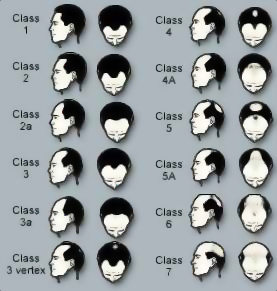
Hair loss and hair multiplication/hair cloning: What the future holds
For many years, hair loss sufferers and balding patients with few donor hairs for hair transplantation have been dreaming of the possibility of finally being able to multiply/duplicate hair. What does the future hold in terms of hair loss and “hair cloning” and what is the current state of research? In this article I would like to take a closer look at the future of hair transplantation and hair reproduction (hair cloning)
There are no gender boundaries when it comes to hair loss. Both men and women suffer from thinning hair and reduced self-esteem, depending on the severity. The reasons are manifold. In the case of hereditary hair loss (androgenetic effluvium / alopecia), however, medical treatment methods are still limited to this day. While androgenetic alopecia in men often begins very early and can progress to baldness, the situation is somewhat different in women. In women, hair loss usually begins during the menopause and takes on a different form as it progresses. Complete baldness usually only occurs in men with a genetic predisposition. The cause of hereditary alopecia is the hormone dihydrotestosterone (DHT), which through its interaction leads to accelerated growth cycles and thus, depending on disposition, causes the hair on the human head to atrophy. The result is well known: a visible thinning of the hair up to a complete baldness (in men).
Since the beginning, medicine could not offer adequate and helpful treatments until the side effects of two drugs were discovered by chance: Minoxidil and Finasteride. Both are available in pharmacies under the names Regaine and Propecia and still dominate the market of drug treatments for hereditary hair loss. However, their effects are limited and cannot in any case maintain or bring back the amount of hair once seen on the heads of affected individuals.
Research results in the early 2000s showed that the hereditary cause must lie in the genes of the grandfather from the maternal line (DER SPIEGEL reported in 20051). However, this did not mean that the entire causes had been identified. To this day, the mystery has not been completely solved and no effective remedy for baldness has been found.
Hair transplantation: Surgical redistribution of hair

Since the medicinal methods of application have not proven to be sufficient or promising in many cases, surgical hair transplantation with the redistribution of healthy donor hair to bald areas using different methods has become a supreme discipline at a very early stage. The techniques (FUE or FUT )are used to remove hair follicles from the genetically unproblematic hair crown, isolate them and transplant them into the problematic areas. Even body hair and beard hair can now be redistributed in this way with limited effect. However, the absolute limits of this therapy lie in the availability of so-called donor hair.
Limits of autologous hair transplantation and the desire to clone hair: Number of donor hairs in the hair ring is limited
Successful results can only be achieved with hair transplants if sufficient healthy donor hair is available. In men, this can be recognised by the ring of hair, which usually remains in a horseshoe-shaped arrangement on the head while the remaining hair is already falling out. However, if it has already come to the point where the hair has completely fallen out, a hair transplant can usually no longer have any effect. According to simple arithmetic, a crown of hair must be able to be reduced to an average of 30-40% of its available substance in order to enable a fair redistribution within the framework of a transplant. However, if the resources of the donor area are strained too much by the removal of the hair follicles, a hair transplant will not promise success. Patients who have reached a status of 7 on the Norwood scale are therefore excluded from transplantation, and in patients with, for example, NW 6, larger areas such as the complete tonsure (rear area) often have to remain unplanted.

Classification of baldness status according to the NW scale
So what solutions are there for these people without hair and what development can the treatment of hair loss take? Hair surgery and renowned doctors have addressed this question.
HAIR REPLICATION: Hair Multiplication / Hair Replication / The Cloning of Stem Cells / Haircloning

When the news of the cloned sheep “Dolly” dominated the media in 1997, many people were outraged by the self-righteous claim of creation by genetics. On the other hand, this breakthrough also promised new hope. Expectations now range from curing diseases to aesthetic hair replication or cloning hair and healthy stem cells.2 The limitations of autologous hair transplantation are limited donor sites and advanced alopecia. In this situation, the only option is to multiply/clone hair. However, multiplication and cloning are understood to be two different things when looked at closely. Therefore, it is first important to differentiate precisely between the terms.
Hair multiplication: It is a matter of “hair reproduction”
Hair multiplication is not, in the strict sense of the word, a laboratory-generated hair reproduction in which stem cells are extracted. One of the specialists who deal with the issue of hair multiplication are Bosley and Aderans (http://www.bosley.com). They distinguish between the type of hair multiplication that has been practised for a long time and cloning.3
Hair Multiplication Dr. Gho Hair Stem Cell Transplant HST
Hair multiplication, as practised by Dr. Gho (Dr. Gho Hair Stem Cell Transplant (HST)) in the late 1990s and early 2000s, involves splitting hair follicles (hair splitting / hair splitting). The idea behind this is that hair roots usually develop further during splitting and that two or more can be created from one hair in the end, so that only a part of the follicle (a few “hair stem cells”) is needed to grow one or more new hairs. In this way, even a limited donor volume should lead to new hair follicles through reproduction.
However, opinions have remained divided on the evaluation of this method and its success to date. Experts speak of fruitless attempts4which are probably no longer being intensively pursued.
Hair Cloning: Hair is cloned in the laboratory / Stem cells for hair

In hair cloning, too, hair follicles are first removed (e.g. minimally invasive). During a subsequent in vitro isolation of stem cells in the laboratory, theoretically thousands of new cell cultures for hair follicles are then generated by copying (cloning) the stem cells. These cells are then injected into the patients’ problem areas, where they are supposed to stimulate new hair growth after a while. The scientific journal “Proceedings of the National Academy of Sciences of the United States of America” (PNAS) speaks in this context of three-dimensional cell cultures that retain the “ability to form hair”.5 With this method, all that is basically needed is a single healthy hair follicle to produce full head of hair on a previously bald scalp. This would give new hope especially to people with hereditary hair loss and increased baldness. But this method is also said to promise confidence to patients suffering from diffuse hair loss or who have suffered hair loss due to accidents (burns, etc.).
Interested readers can also read about the exact procedure of how the stem cells are cloned in Ebuni Ajiduah’s description.6 Confidence in the research world and among renowned hair surgeons like Dr. Umar7 grows every year with new advances that become known.
But why is it not yet possible for affected patients to achieve more hair growth by cloning hair follicles? Here are some brief explanations.
Hair cloning: Concerns, problems and limitations
So far, there are no long-term studies that promise sustained success of stem cell cloning for hair loss. Even in the case of a successful regrowth of hair (better: new growth of hair), aesthetically unsatisfactory after-effects could result from unusual growth directions, pigment differences, etc. in the new or reproduced hair. The result of a treatment could suffer from the fact that cloned hair makes the later appearance appear unnatural. The body’s own defence reactions cannot be ruled out either. In this context, Dr. Umar also refers to three-dimensional cell cultures, whose chances of survival, however, cannot be assured at present because they either do not promise a long life compared to existing cells or have a shortened cell cycle that leads to premature failure.8
What are the risks of stem cell cloning?
Since the method of cloning is not yet medically approved, risks and successes must be weighed. There is currently no valid proof among doctors and researchers that cloned stem cells lead to the desired success in the body of a human being without also ruling out disadvantages. So far, success has only been demonstrated in mouse experiments. In this context, Dr. Serkan Aygin points out that any treatment with cloned cells can also involve the risk of cancer.9 Since human cell cultures are artificially reproduced, there is at least the possibility that malignant cells are produced which cause lasting damage in the donor area of the human being. Of course, there are also the usual risks, from severe bleeding to infection.
The costs of hair replication (hair propagation through hair cloning) are not yet foreseeable given the current state of research. In addition, there are different legal approval requirements for such a treatment method in all countries. It is therefore to be expected that a treatment will only become affordable for a broad mass when a uniform and area-wide offer situation and a valid prospect of success has been established.
Further approaches to hair multiplication / stem cell treatment / cloning
The Columbia University Medical Center10 reports advanced studies in which stem cell cultures from hair follicles have now shown the known problems. According to these studies, cloned two-dimensional cells mutate into ordinary skin cells as soon as they are injected into the problem areas and therefore could not achieve the desired effect. Therefore, cells have to create their “own intercellular environment” in which it is possible for them to “reprogram” the environment of the receiving area. Even here, long-term survival and exact adaptation, including growth direction and pigmentation, cannot yet be guaranteed. Although these research results are encouraging, at this stage they indicate that there is still a long way to go before hair propagation or stem cell cloning becomes a reliable and promising treatment method for patients with advanced alopecia.
Hair multiplication: companies and institutions in the focus of research – hair cloning as a research priority
One of the early companies involved in the research of stem cell cultures from hair follicles was the aforementioned Aderans Research Institute. The company, which originated in Japan, isolated strips of skin from the donor area at an early stage in the USA in order to cultivate cells from them, which were then multiplied. In the experimental programmes, however, hardly any promising hair multiplications were achieved recently. Instead, the cells could be revitalised to prevent further hair loss. However, the actual goal of generating new hair was not achieved. The company has since stopped investing in hair multiplication research.
Similar to Aderan, Intercytex from Cambridge (UK) also developed research priorities in the field of stem cell research very early on. Initial success was achieved in cloning the first stem cells and then transplanting the hair follicles into the areas affected by hair loss, as two-thirds of all male test subjects were able to demonstrate new hair growth. Unfortunately, further tests in the third phase were no longer successful. In addition, the company had to cope with financial bottlenecks, so that the hair multiplication programme was discontinued.
The most advanced research on stem cells at the moment is being conducted at Durham University in England. There, they have already switched to cloning three-dimensional stem cells instead of two-dimensional cells. Trials of human cells on rats have shown that the cells actually formed healthy hair follicles to grow new hair just 6 weeks after they were injected. One of the key innovations was that the dermal papillae could reprogram the cells of the new environment when they were injected, an approach also mentioned in the studies of Columbia University above. However, there were problems with this too: a proportion of hairs grew back without pigmentation.
It is hoped that this research approach will be pursued further and perhaps contribute to a revolutionary development in the treatment of hair loss.
Prospects and perspectives? Concluding remarks
What options do affected individuals with problematic donor sites now have to inform themselves about developments in hair multiplication (i.e. hair cloning)? The internet and social media keep informing about further developments on an understandable level.
Forum overview: Forums dealing with the topic of CLONING
In international and German forums, interested people can obtain up-to-date information about the latest progress in hair multiplication. Below are some non-binding sites that regularly or partially report on the topic of cloning and the state of research:
- https://hairsite.com/hair-multiplication/archives/
- https://www.alopezie.de/fud/index.php/f/27/
- https://www.baldtruthtalk.com/
Sources/references and author
2 See also the essay by Dr. Serkan Aygin: https://drserkanaygin.com/hair-transplantation-with-stem-cells-hair-cloning
3 https://www.bosley.com/blog/hair-cloning-and-regeneration/
4 https://hairsite.com/hair-multiplication/
5 https://www.pnas.org/content/early/2013/10/16/1309970110
6 https://gettik.com/hair-cloning/
7 https://www.quora.com/Will-hair-cloning-or-hair-multiplication-become-a-reality-in-the-near-future
8Quote from Dr. Umar (op. cit.): “It is ever getting closer. But there is no predicting when it would happen precisely. There is going to be eureka moment that would dominate the news when it does happen. Every 2-3 years, a hurdle in the research pathway gets solved, and a new one bubbles up. The problem of getting derma papilla (dp) cells to aggregate and form hair follicles got resolved by 3d casting of the cells, but the hairs that form would not survive the beyond one or more hair cycles. But the research on hair cloning and hair multiplication…”
9 https://drserkanaygin.com/hair-transplantation-with-stem-cells-hair-cloning
10 https://www.cuimc.columbia.edu/news/hair-regeneration-method-first-induce-new-human-hair-growth
Author
Andreas Krämer/Hairforlife Expert Editors


